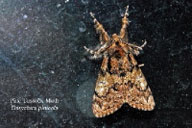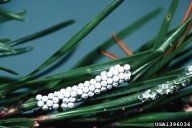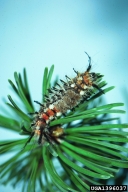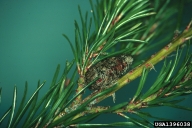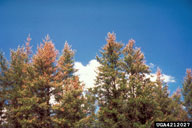Pine tussock moth
Dasychira pinicola (Dyar) Lepidoptera: Lymantriidae)
Orientation to pest
Pine tussock moth, Dasychira pinicola (Dyar), is a native North American tussock moth. It is known for sudden eruptions in population that quickly subside and may not occur again for many years. It is found in southeastern Canada and from the northeastern United States west to Minnesota. The larvae feed on various conifers, especially on jack pine (Pinus banksiana Lamb.) Outbreaks, when they do occur can be extensive and damaging since the caterpillar stage consumes both new and old foliage, leaving host conifers completely defoliated. In the last century there have been several large outbreaks on jack pine in the Lakes States. In the Lake States, moths fly in mid-summer and eggs are laid in irregular clusters on or near the female pupal case, on the needles or the trunk. Eggs hatch later in the summer and young larvae feed on needles until they reach the second or third instar, when they go into hibernation for the winter. Larvae resume feeding in the spring, at first eating staminate flowers and young needles. Later, old-needles are also eaten. Fully grown larvae spin cocoons on needles or twigs, where they also pupate. Moths emerge shortly thereafter. There is one generation per year.
Hosts commonly attacked
The caterpillar stage of pine tussock moth feeds on various conifers, including jack (P. banksiana), red (Pinus resinosa Sol. ex Aiton), and eastern white (Pinus strobus L.) pines, spruce (Picea) and balsam fir (Abies balsamea [L.] Mill.).
Distribution
Pine tussock moth is found in southeastern Canada and from the northeastern United States west to Minnesota.
Images of pine tussock moth
| Figure 1. Adult of pine tussock moth, Dasychira pinicola | Figure 2. Eggs of the pine tussock moth | Figure 3. Larva of pine tussock moth |
| Figure 4. Pupa of pine tussock moth | Figure 5. Jack pines damaged by pine tussock moth |
Important biological control agents related to this pest species
Natural enemies of this species have been studied during outbreaks that occurred in Wisconsin in the 1960s. Thirty-one parasitic species were reared during that study. Eight insect predators and four pathogens were also reported. Parasitism levels were significant in the egg, larval and pupal stages (see Sreenivasum et al. 1972 for details).
Articles
- Sreenivasam, D. D., D. M. Benjamin, and D. D. Walgenbach. 1972. The bionomics of the pine tussock moth. Research Bulletin No. 282. School of Natural Resources, College of Agriculture and Life Sciences, University of Wisconsin, Madison, 36 pp.
